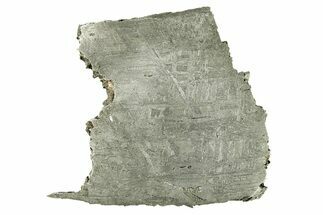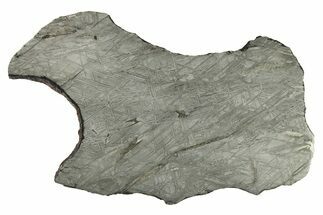2.42" Etched Gibeon Iron Meteorite (43g) Slice - Namibia
This is a 2.42" wide (43.0 gram) etched slice of the Gibeon iron meteorite from Namibia. It shows a very nice Widmanstätten patterns and fully stabilized through reverse electrolysis and coated to prevent rusting. It comes with an acrylic display stand.
The Gibeon Meteorite
The Gibeon meteorite is an iron (IVA) meteorite that fell in Namibia thousands of years ago. Its strewn field is by and far the largest in the world: it covers over 46,000 square kilometers! It was known by the Nama people of southern Namibia and used as for various tools and weapons including their assegais, a kind of spear common among many sub-Saharan African cultures.
The meteorite was discovered by Western cultures in 1836 when an English expedition found samples near the Fish River and brought them back to London for study. Since then, over 26 metric tons have been recovered. 29 pieces are prominently displayed as part of a fountain in the Post Street Mall, part of the business district of Windhoek, the capital of Namibia. It is considered a national monument.
Gibeon is a classic example of an octahedrite, displaying some of the best Widmanstätten patterns seen on any known meteorite. The lines make it a popular choice for specimen collection and jewelry.
The Gibeon meteorite is an iron (IVA) meteorite that fell in Namibia thousands of years ago. Its strewn field is by and far the largest in the world: it covers over 46,000 square kilometers! It was known by the Nama people of southern Namibia and used as for various tools and weapons including their assegais, a kind of spear common among many sub-Saharan African cultures.
The meteorite was discovered by Western cultures in 1836 when an English expedition found samples near the Fish River and brought them back to London for study. Since then, over 26 metric tons have been recovered. 29 pieces are prominently displayed as part of a fountain in the Post Street Mall, part of the business district of Windhoek, the capital of Namibia. It is considered a national monument.
Gibeon is a classic example of an octahedrite, displaying some of the best Widmanstätten patterns seen on any known meteorite. The lines make it a popular choice for specimen collection and jewelry.
About Iron Meteorites
Iron type meteorites are composed primarily of iron and nickel, and are the remnants of differential cores torn apart at the beginning of the solar system. These metallic meteorites are often the easiest to identify after millions of years post-impact because they are quite different from terrestrial material, especially when it comes to their mass-to-surface area ratio. They are exceptionally heavy for their size since iron is a high-density metal: this is also why the Earth's core is nickel-iron. As planets form, the densest metals form gravitational centers, bringing more and more material into their gravitational pull. In the solar system's rocky planets, these dense materials are most often nickel and iron.
Most iron meteorites have distinctive, geometric patterns called Widmanstätten patterns, which become visible when the meteorite is cut and acid etched. These patterns are criss-crossing bands of the iron-nickel alloys kamacite and taenite that slowly crystalized as the core of the meteorites' parent bodies slowly cooled. Such large alloy crystallizations for mover millions of years and do not occur naturally on Earth, further proving that iron meteorites come from extraterrestrial bodies.
Iron type meteorites are composed primarily of iron and nickel, and are the remnants of differential cores torn apart at the beginning of the solar system. These metallic meteorites are often the easiest to identify after millions of years post-impact because they are quite different from terrestrial material, especially when it comes to their mass-to-surface area ratio. They are exceptionally heavy for their size since iron is a high-density metal: this is also why the Earth's core is nickel-iron. As planets form, the densest metals form gravitational centers, bringing more and more material into their gravitational pull. In the solar system's rocky planets, these dense materials are most often nickel and iron.
Most iron meteorites have distinctive, geometric patterns called Widmanstätten patterns, which become visible when the meteorite is cut and acid etched. These patterns are criss-crossing bands of the iron-nickel alloys kamacite and taenite that slowly crystalized as the core of the meteorites' parent bodies slowly cooled. Such large alloy crystallizations for mover millions of years and do not occur naturally on Earth, further proving that iron meteorites come from extraterrestrial bodies.
$215
TYPE
Iron, IVA
LOCATION
Namibia
SIZE
2.42 x 1.68", 0.115" thick, Weight: 43.0 grams
CATEGORY
SUB CATEGORY
ITEM
#272612
 Reviews
Reviews









